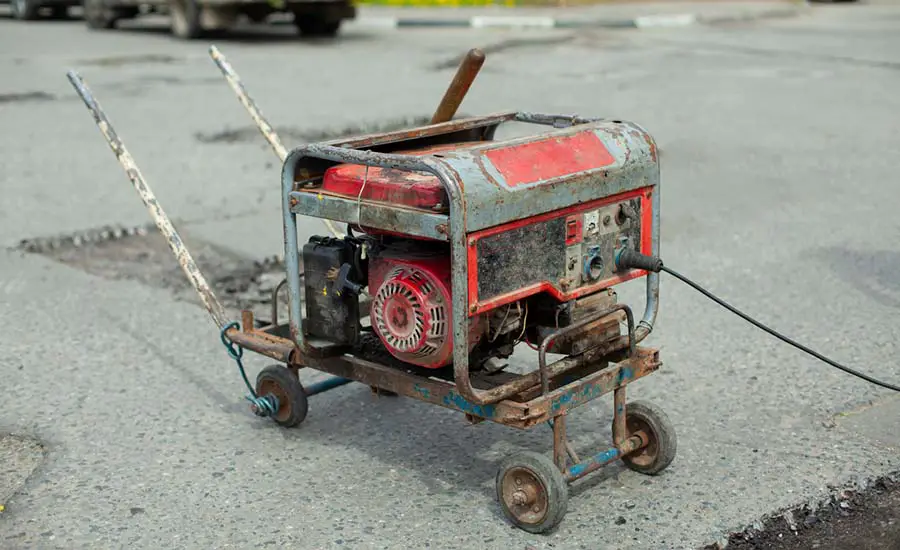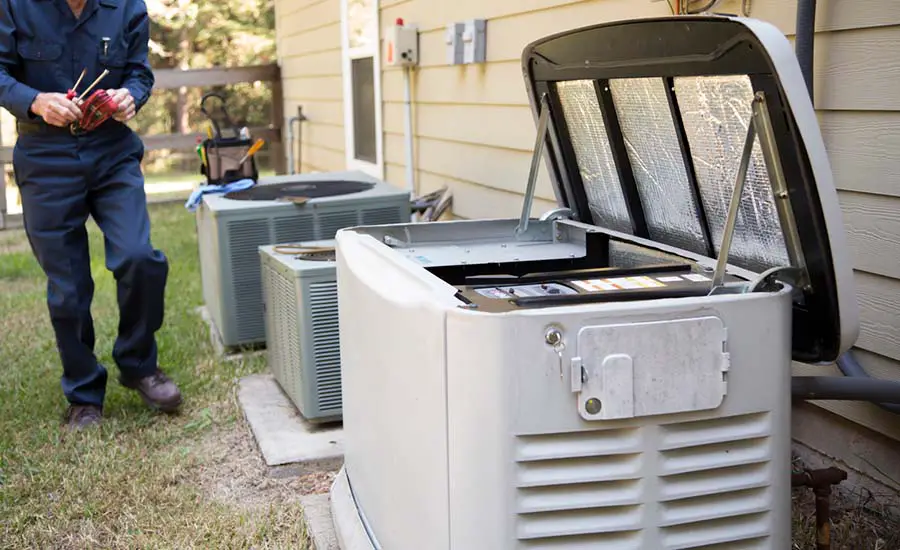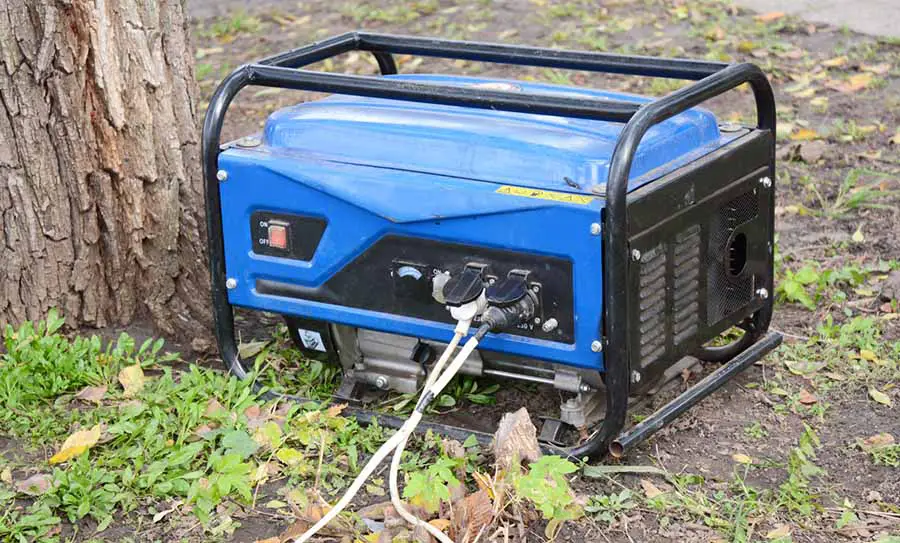
All generator purchases should come with a standard booklet highlighting some of the reasons why your generator might stop working. This would help you navigate the dreaded reality of both the power grid and your generator not working simultaneously, possibly in the middle of winter. These booklets usually only cover a few troubleshooting suggestions, and this post aims to give you some more helpful ones should your generator stop working.
The 12 most common reasons that your generator stops working are the following.
- Low Fuel
- Low oil
- On switch is off
- Dead battery
- Choke too open/closed
- Clogged carburetor
- Blocked air filter
- Jammed fuel valve/line
- The low oil sensor is defective
- Damaged spark plug
- Generator overload
- Automatic transfer switch
When you lose power because your generator stops working, you must know where to look and what to look out for to find the fault. A bonus is knowing how to fix the problem when you find it. You might be in a dark place when your generator stops working, but by working through the possible reasons, it might just be a simple old spark plug that needs replacing.
Common Reasons Why Your Generator Stops Working
Should your generator decide to stop working one day, do not panic or throw it in the dump. Eliminate these twelve most common reasons first before making any hasty decisions.
1. Low Fuel
- Start by checking the fuel level first; this is an easy mistake to make and easy to rectify.
- Fuel gauges are problematic at times, especially with regards to the information that it is displaying.
- If your generator has a type of low-level shut-off mechanism in its design, and your gauge is inaccurate, it could lead to your generator stopping to work, even if the fuel level is sufficient.
- If you are using gasoline, and it has been in your tank for more than 2 months, it could have gone stale. Stale gasoline will damage your engine. Should the gasoline be stale, remove it from your carburetor and fuel tank, replacing it with fresh gasoline.
2. Low Oil
- Check the oil levels of your generator by using the oil dipstick. Make sure that you are using the right oil when you are filling up low levels, as per manufacturer instructions.
- If your generator does not have a low oil sensor and the oil is very low, the engine could have been damaged.
3. On/Off Switch
- Another easy mistake to make is having your main control switch set on ‘off’ or ‘reset’ instead of ‘on.’
- Switch the main control switch to ‘on’ and try to start the generator.
4. Dead Battery
- If your generator starts via electric starter (push-button or remote), check if the battery of this starter could flat; if so, the battery won’t start, and the generator won’t work.
- If your generator has an auxiliary recoil starter, try to start it this way; if it starts, simply continue to charge the starter battery via the 12-volt DC outlet.
- Make sure all your batteries, cables, chargers, and connections to and from your generator are in working condition.
- You can also charge the generator battery by using jumper cables and jump starting it using your car battery
5. Choke Is Too Open/Too Closed
- The choke’s main function is to control the airflow to the fuel during the combustion process. If there is too much air or not enough air, this might be the reason why your generator won’t start.
- When starting the generator, put the choke on the full/start position. After a few seconds of running, push it to the half setting and then to the run position.
6. Clogged Carburetor

- Old gasoline left in a carburetor for more than a month could have formed clogs, stopping new fuel from getting through the carburetor and to the engine.
- To fix this problem, start by closing the fuel valve, and take out the carburetor’s reserve bowl.
- Clean the bowl with a brush and cloth, making sure all fuel deposits are removed.
- Unclog the jet nozzle with a pin/needle.
- Open the fuel valve before trying to start the generator again.
7. Blocked Air Filter
- Try this if you have already adjusted the choke and almost got the generator started.
- Now it’s time to check your air filter to see if it’s blocked with any debris or dust particles. If so, it will hinder the air combustion process.
- Replace the air filter immediately and try starting the generator again, making sure the choke is in the correct position.
8. Jammed Fuel Valve/Line
- In addition to blocking your carburetor, old fuel can also block your fuel valve.
- To check this, open both your fuel valve and vacuum relief valve, should your generator have one.
- To test if fuel is freely flowing to your engine, unhinge the hose from the inlet side of the fuel valve and have a bucket ready for overflowing fuel.
- Make sure to check the filter between the carburetor and fuel valve for any clogging.
- See if all fuel lines are in order and not pinched by something, as this could also prevent the engine from receiving fuel.
- Make sure your generator’s shut-off valve is open (located on the fuel cap). If it is closed, the generator will start on old fumes and fuel only, will only run for a while, and eventually, it will die on you.
9. Low Oil Sensor Is Defective
- Check to see if your generator is stationed on a level surface. If not, it can cause this sensor to misread the oil levels and cut off the engine as a safety precaution, even if you have sufficient oil in the engine.
- After checking the oil level, and you are satisfied that there is enough oil in your engine, test the sensor by unplugging its wire from the crankcase. If it starts up, then you know that the sensor could be faulty and needs replacing.
10. Damaged Spark Plug
- Take out the spark plug, check for mucky carbon sediments and dirt.
- To test the plug, press it against the crankcase while pulling on the recoil starter; if it is functioning properly, it should produce sparks.
- The best option is just to replace it with a new one, as this is a relatively cheap engine part.
11. Generator Overload

- It might well be that your generator refuses to work due to overloading.
- Start by turning off some non-essential devices and see if it improves the situation.
12. Automatic Transfer Switch
- Some generators start up automatically when there is a power outage.
- If this is not the case, go check that the automatic transfer switch is displaying that it is indeed on.
- Do NOT touch this button, as it could lead to serious injury.
- When power is restored, your generator will normally continue to run for 15-30 minutes, as it hands over the duty to the power grid supply. If your generator keeps on running even when the power comes back on, it is time to call a professional.
Conclusion
There will come a time in any generator’s life when it will stop working. The reason for this could be something minor, like putting in some fuel, or something big like a faulty oil sensor, for example. By inspecting the common reasons why this could have happened, you will hopefully identify the problem quite quickly and get your generator up and running again.
Regularly servicing your engine will reduce the possibility that it will stop working to a degree. Replace your oil often, and do not use stale fuel. Check the filters now and again and invest in new spark plugs. When it comes to generators, prevention is most certainly better than cure, so always aim to keep your generator up and running by performing regular maintenance.
If you have gone through all the different scenarios above and your generator still refuses to work, there is no shame in roping in a professional to assist. At least you know that you have tried almost everything that you could to solve the problem yourself.
